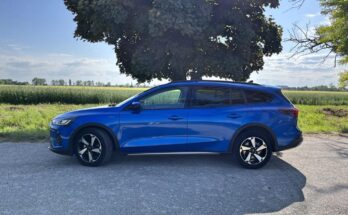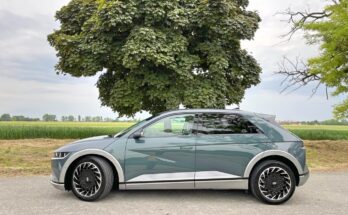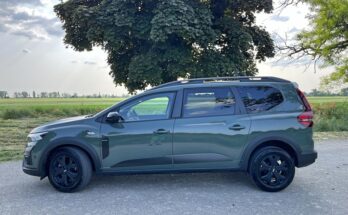Kodiaq is the first medium-sized SUV from a traditional Czech brand. The model has been on the market since 2016, so it is not a hot new product. The reason for the test is the new Sportline equipment, which refreshes the car's design with sporty exterior and interior accessories. "With the soul of a racer" – this is the slogan proposed by the car manufacturer for this equipment. How close is this slogan to reality?
From the outside
When the Kodiaq hit the market, I had mixed feelings about it. I was not too impressed by its design, it was conservative and the car disappeared on the road among similar SUVs. Its shapes stood out only with the use of the right color, large wheel rims and accessories. Perhaps that is why the manufacturer comes with equipment lines Scout and Sportline. How little is enough to turn a car with an average design into something that turns heads on the street. The optional red Velvet metallic also contributed to this, which emphasizes the edges and moldings of the exterior and is in contrast with the black accessories that are part of this equipment. The changed front bumper, black radiator grille without a chrome frame and the dark background of the front and fog lights can reliably distinguish the tested Kodiaq from other equipment variations.
On the side of the car, the black rear-view mirror covers and the lacquered lower part of the doors are removed. Like the front fascia, the chrome window trim has also disappeared and has been replaced by black plastic. I consider wheel rims to be a work of art. The 20" wheels perfectly fill the large angular fenders.
I also find dark elements on the roof. Additional skids suitably finish the high silhouette of the vehicle. The rear part tries to be different by dark framing the lights and…
I don't understand the current trend of replacing real tailpipes with fake ones, sometimes even just a chrome frame to indicate their shape. The desired sporty shapes would only be enhanced by distinctive exhaust tips. Skoda also joined this trend. In this regard, I am of the opinion that if there is no interest on the part of the designers to admit the exhausts and even more to emphasize them with nice ends, it is better to leave the rear bumper completely without their indication and keep its clean lines.
Except for this element, I rate the exterior of the Skoda Kodiaq in Sportline equipment as successful and attention-grabbing.
Inside
When I took a quick look at the interior, two elements of the equipment immediately caught my attention: the small, beveled steering wheel at the bottom and the sporty front seats. Other differences are only cosmetic in nature, such as a red light line on the doors, decorative elements on the dashboard with carbon imitation, aluminum pedals. Similar to the exterior, these elements make the rather conservative character of the interior special and give it a certain flair that the standard model lacks. However, the designers did not avoid the abundant use of piano varnish on the places that come into contact with the hands and therefore need to be cleaned and polished and cleaned and polished…
The production of plastics is exemplary, I see a problem precisely in the processing of the door handles, which creaked unpleasantly when handling them. I felt embarrassed by the simple instrument panel, which is certainly not suitable for one of the brand's top models. In addition, the black numbers on the devices are placed on a gray background and are therefore not easy to read. Fortunately, this matter can be solved with an additional digital shield, which will give the device a different and luxurious dimension.
I liked the dark upholstered ceiling with pillars, which followed the luxuriously stitched sports seats in a combination of leather and Alcantara with integrated headrests. The door panels are also upholstered with Alcantara, which softens their large area.
The luxurious-looking infotainment with a 9.2" touch screen is located high enough and is conveniently controlled thanks to the large settings icons. Still, I appreciate that the controls for ventilation and a few other functions have remained in the realm of single-purpose hardware buttons. I was pleased with the Android Auto/Apple Car Play support, which I regularly used while driving.
Driving
Ground clearance of 189 mm and higher anchored seats allow for comfortable boarding. I notice the fair overlap of the lower part of the door. When put on, I'm surrounded by a space with a capital P. I can't imagine anyone could complain about its lack in any direction.
After a long time, I have no problem with the location of the lumbar support, as it is adjustable in four directions. The seats are more comfortable than they appear at first glance. They are richly dimensioned and their lateral guidance fulfills its role as a unit. Even in the lower position, they provide a typical "chair" SUV sitting position, which, however, looks natural and fits this class of vehicle.
The steering wheel adjustment is not extensive, but I personally was able to find the ideal position very quickly. A great sports steering wheel with a thick rim makes you forget the type of car I'm sitting in right now. I got used to controlling the basic functions of the audio system and switching between displays of the on-board computer using the buttons on the steering wheel in a short time.
I have no reservations about the layout of the controls, but I would rather see the cruise control on the steering wheel than on a separate lever. But it's just a matter of habit. I appreciate the comfortable and longitudinally and height-adjustable armrest, as well as the control lever of the automatic transmission located within natural reach.
On the road
Due to the wear of the tested car, I did not trouble it in off-road conditions, but I checked it all the more thoroughly on normal roads.
The car was powered by the company's 2.0 TSI petrol engine with a volume of 1984 cm 3 , a maximum power of 132 kW achieved between 3900-6000 revolutions and a maximum torque of 320 Nm at 1400-3940 revolutions. Within the VW concern, this is an engine delivered to various models with different power settings. This is one of the lowest values for the tested Kodiaq. Maybe that's why it has a somewhat stifled impression at higher revs. However, this does not mean that it is an overall weak engine, but it has more of a diesel character. It gives its best up to a value of approximately 4000 revolutions, when it is also pleasantly quiet and makes itself known only when it is exceeded.
The engine is seconded by a 7-speed dual-clutch DSG transmission with the option of a sports mode and also manual shifting using levers under the steering wheel. In most situations, he gives advice quickly and at the right moment. However, it is a problem to set a suitable gear when there is a need for sharp acceleration using kickdown. In this case, sometimes he shifts too low a gear senselessly and the revolutions rise to 5000, where the engine not only seems sleepy, but after a short while it shifts again and the revolutions are again at a similar value. In this discipline, I recommend not to use the mentioned kickdown at all. I achieved the best acceleration values when the transmission was set to sports mode and gentler pressure on the accelerator. At lower speeds, it is also necessary to take into account a certain delay in the engine's reactions caused by the low pressure to spin the turbocharger.
On the opposite side, when trying to start gently, moving with a step, or reversing, I didn't notice any of the jerking and jerking typical of dual-clutch transmissions in the past.
In the city, despite its dimensions, the car handles very well, as evidenced by the turning diameter of 12.2 m. Very easy steering also helps him in this. Due to the height of the vehicle, there is no problem with the view in any direction. However, I would welcome larger rear-view mirrors. Reversing is simplified by a 360° camera with excellent resolution and the ability to switch between individual cameras.
The optional adaptive chassis, even in the comfort setting, could not fully absorb the transverse irregularities that the car crew not only heard, but also felt. I blame it on the beautiful, but big and heavy wheels with a low profile. In this case, I would stick with the serial nineteens.
In the city, the disadvantage of a relatively large gasoline engine became apparent. In heavy traffic, the consumption easily exceeds 11 liters and it is almost impossible to reduce it.
On the roads, with a reasonable use of the gas during brisk driving, the power of the engine could be felt, and the car could be had fun within the limits of the class. However, when going through sharp turns quickly, it soon went into a skid, which was immediately corrected by the stabilization system. Longer and not so sharp turns, however, Kodiaq passed stably with pleasantly small leans. It was with them that I appreciated the excellent side guidance of the sports seats.
I mostly drove in the neutral Normal mode, which probably suited me the most. The sporty one stiffened the chassis too much, which copied every unevenness, and after a while it started to become uncomfortable. Although the steering stiffened a little, it still felt overpowered and unweighted. Comfort mode was not far from "Normal" and could not filter out some unevenness due to the already mentioned large wheels. I didn't get a chance to compare the adaptive suspension to the standard one, but it would probably be an item I would skip when ordering a Kodiaq.
Outside the city, consumption can be maintained at a value of around 8l/100 km, even during sharp driving full of overtaking and vigorous acceleration at the end of the village. To reduce it, smooth driving at a speed of up to 110 km/h is necessary, where a value of 6.6 liters can be reached. The increased speed and every acceleration will already sign on its increase. I was pleasantly surprised by the gradual onset of the brakes and their effect, which can be finely dosed.
I was satisfied with the consumption when driving on the highway. At speeds up to 140 km/h, I was able to drive for 8.5 liters, which is a satisfactory value considering the car's construction and weight of over 1660 kg. In windy weather, the engine's appetite increased by one liter, which is due to the aerodynamics of the vehicle, similar to a flying brick. I rate the sound insulation from the engine and chassis as excellent, but the aerodynamic noise around the side windows was not completely filtered out.
I rate the Kodiaq's driving characteristics as stable and predictable within its class. It is necessary to be aware of the weight, height and center of gravity of the car and not to be carried away by the feeling of the sports steering wheel and seats. In this case, the car will reward the driver with a pleasant feeling of acceleration in a straight line and an overall brisk drive. I will return to the slogan "With the soul of a competitor". In my opinion, the marketing department of the importer is exaggerating a bit, the sports accessories still give this model a bit of a racing soul.
Practical page
In this respect, Skoda scores points. Large and richly upholstered compartments in the doors, space under the ventilation controls, two voluminous boxes in front of the passenger (one of which is air-conditioned), a smaller but cleverly divided compartment under the armrest, blinds on the rear side windows, all this makes the Kodiaq a practical companion for long roads. The space in the back seats is truly royal. After setting the front seat "on top" (at a height of 185 cm), there is approx. 10 cm left in front of my knees. There is also plenty of headroom. The rear seats are a little shorter, but still comfortable enough. Folding backrests allow everyone to find a comfortable position. A 230V socket, a 12V socket and a USB port are other pleasant and nowadays almost essential accessories for families with children.
The luggage compartment with a volume of 650 liters is a chapter in itself. You will be pleased with practical details such as sliding hooks, a removable light, pockets on the sides, the possibility of folding the rear seats using levers, all of which belong to the manufacturer's "Simply Clever" solutions. I praise the supplied travel wheel instead of the puncture repair kit. After folding the rear seats, there is no flat surface, but the total volume of 2065 liters makes up for it.
Verdict
Kodiaq almost didn't surprise me with anything, but it didn't disappoint either. I expected a little more from the engine, I was surprised by a few details in the interior. I would leave out the adaptive suspension and 20" wheels when configuring this car. I would definitely pay extra for a digital instrument panel.
The total price of the tested vehicle reached almost EUR 44,000, while the base price with the tested engine and Sportline equipment starts at EUR 39,000. When compared with the competition, I rate this price as appropriate for the car's size, motorization, drive and equipment.
Although the car does not capture the heart, it more than satisfies with its practical side and pleasant and easy handling.




